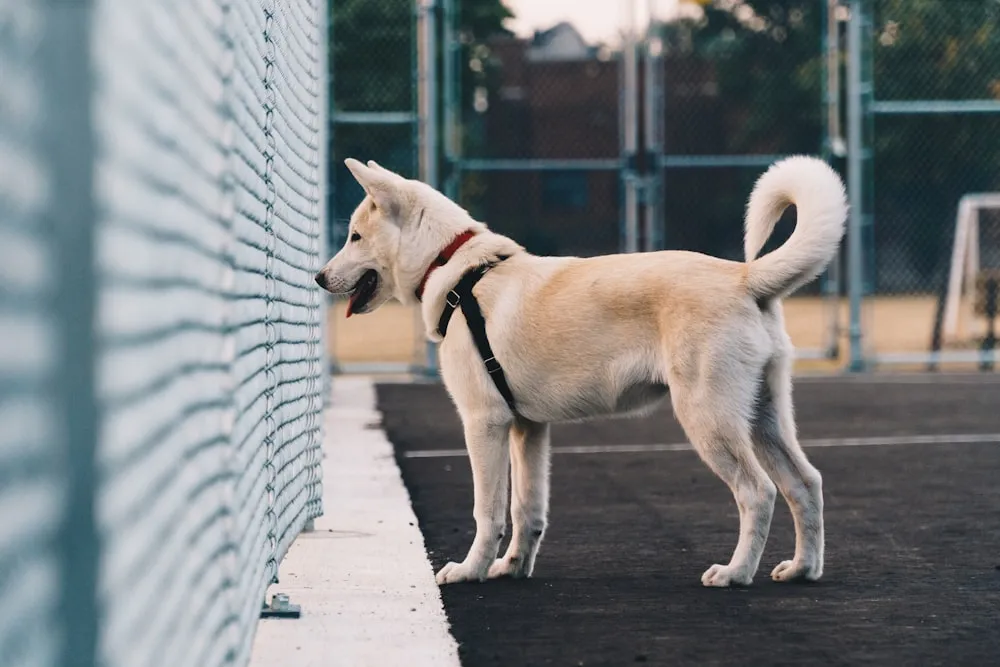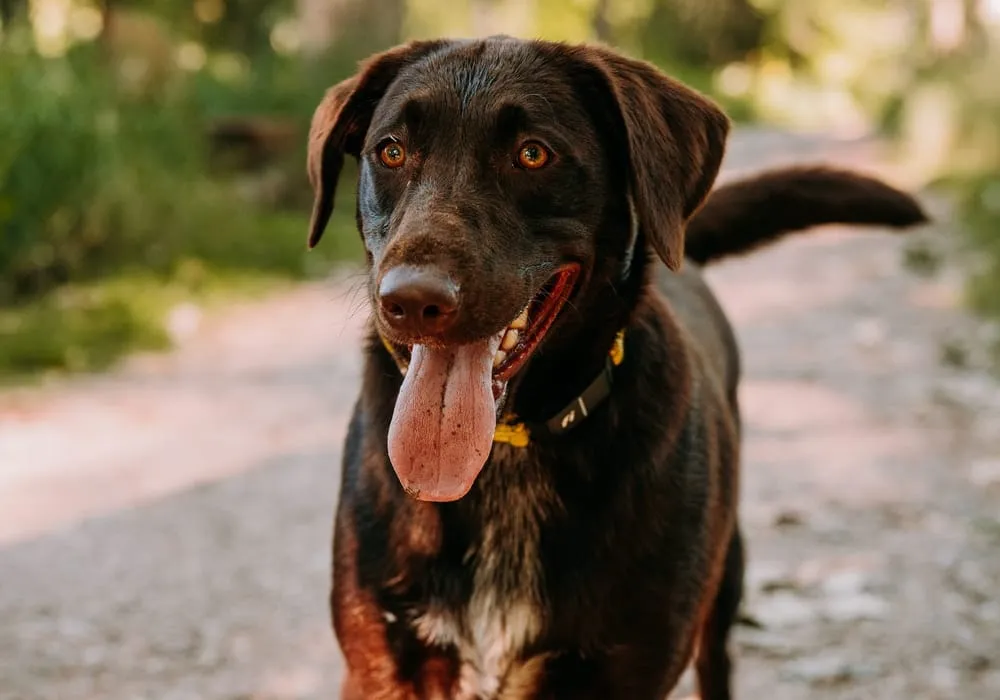Embarking on an RV adventure with your pet brings joy and companionship, but it also demands attention to their safety. The constantly changing environments of RV travel can pose risks to pets, making their security a paramount concern. A portable RV dog fence emerges as an essential solution, offering a safe, enclosed space for your dog to enjoy the outdoors without the dangers of wandering off.
These fences are not only crucial for safety; they also provide peace of mind for pet owners. Easy to transport and set up, they adapt to various landscapes and settings, ensuring your pet has a secure, familiar area at each stop. A portable RV dog fence is thus an indispensable tool for responsible pet owners, enhancing the RV experience by keeping your furry companion safely by your side.
Understanding the Need for a Dog Fence in RV Travel
Traveling with pets in an RV can be a delightful experience, but it comes with its own set of challenges that require thoughtful preparation and understanding. The confined space of an RV, combined with the ever-changing locations and stimuli, can be overwhelming for dogs. These challenges underscore the need for a dog fence during RV travel.
Navigating the Confines and Complexities of RV Travel with Pets
- Limited Space: RVs offer limited space, which can restrict a dog's movement and exercise needs.
- Unfamiliar Surroundings: Constantly changing environments can cause anxiety and stress in pets.
- Distractions and Dangers: New smells, sounds, and sights at different campsites can be distracting or even frightening for dogs, leading to unpredictable behavior.
Risks of Not Having a Secure Area
- Safety Hazards: Without a secure area, dogs are at risk of running off, potentially encountering traffic, wildlife, or other hazards.
- Lost Pets: The risk of pets getting lost increases in unfamiliar and unenclosed areas.
- Campsite Etiquette: Most campsites have rules about pet containment and leash laws, and failing to comply can lead to fines or being asked to leave.
A portable dog fence for RV travel addresses these challenges by providing a designated, secure area for your dog. It allows pets to explore and relax in a controlled environment, reducing anxiety and the risk of accidents or escape attempts. The fence acts as a familiar boundary, creating a sense of home wherever you park, thus helping your pet to adapt more easily to the changing surroundings. In essence, a dog fence in RV travel is not just a convenience; it's a critical component for the safety and well-being of your traveling canine companion.
Types of RV Dog Fences
When traveling with your furry friend in an RV, choosing the right type of dog fence is crucial for their safety and your peace of mind. RV dog fences come in various types, each with its own set of features and benefits. Understanding these differences is key to selecting the best option for your pet's needs.
1. Portable vs. Permanent Solutions
- Portable Dog Fences: These are ideal for RV travel due to their flexibility and ease of assembly. They can be quickly set up and taken down, making them perfect for temporary stops. Portable fences are lightweight, compact when folded, and can be adjusted to fit different spaces.
- Permanent Dog Fences: Less common in RV travel, these are more suitable for those who stay in one location for extended periods. They require a more involved installation and are not meant to be moved frequently.

2. Materials Used
- Metal Fences: Durable and sturdy, metal fences are a popular choice. They often come in panels and can withstand the wear and tear of travel. However, they can be heavier and may require more storage space.
- Plastic Fences: These are lighter and easier to transport than metal options. Plastic fences are less durable but offer more flexibility in terms of design and color.
- Fabric Fences: The lightest option, fabric fences are easy to carry and set up. They are suitable for smaller, less active dogs but may not withstand the strength of larger breeds.
3. Size and Height Variations
- Size: The size of the fence depends on the available space and the size of your dog. Larger breeds require more space to move around comfortably.
- Height: The height of the fence should be based on your dog's size and jumping ability. Taller fences are recommended for larger or more active dogs to prevent them from jumping over.
When selecting an RV dog fence, consider your travel style, the size and activity level of your dog, and the material that best suits your needs. Whether you choose a portable or permanent solution, the right dog fence will provide a safe and enjoyable outdoor experience for your pet during your RV adventures.
Key Features to Consider When Choosing an RV Dog Fence
Selecting the right RV dog fence requires careful consideration of several key features. These features not only ensure the safety and comfort of your pet but also contribute to a hassle-free travel experience for you. Here are the essential factors to consider:
1. Durability and Stability
- Material Strength: Choose a fence made from materials that can withstand outdoor elements and the energy of your dog. Metal fences offer robustness, while high-quality plastic can provide a good balance of durability and weight.
- Stability in Various Terrains: Ensure the fence remains stable on different types of ground, from grassy areas to uneven surfaces.
- Weather Resistance: The fence should be capable of withstanding various weather conditions like wind, rain, and sun exposure without deteriorating quickly.
2. Ease of Assembly and Disassembly
- Simple Setup: Look for fences that can be easily assembled and disassembled, as this is crucial for frequent travelers. The less time and effort it takes to set up, the more time you have to enjoy your destination.
- Tool-Free Assembly: Preferably, the fence should not require any special tools for setup, making it more convenient to use anywhere.

3. Portability and Storage
- Lightweight Design: A lighter fence is easier to move and reposition, important for regular adjustments.
- Compact Storage: The fence should fold or disassemble into a compact form for convenient storage in your RV, without taking up too much space.
4. Safety Features
- Smooth Edges and Secure Latches: To prevent injury, the fence should have smooth edges and corners. Secure latches and locks are essential to ensure that your pet can't open the fence and escape.
- Visibility: Consider fences that allow you to keep an eye on your pet from a distance, ensuring they are safe at all times.
By prioritizing these key features, you can choose an RV dog fence that not only secures your pet effectively but also adds convenience and ease to your travel adventures, making for memorable and worry-free trips with your furry companion.
Alternatives to Physical Fences
As an alternative to traditional RV dog fences, the Fi dog collar offers a high-tech solution for keeping your furry friend safe during your travels. This innovative product stands out with its geofencing feature, providing a modern and efficient way to monitor and protect your pet.
Introducing the Fi Dog Collar: A High-Tech Alternative
The Fi dog collar is designed for the tech-savvy pet owner who seeks convenience and peace of mind. It's a cutting-edge device that combines GPS tracking with a customizable geofence feature. This allows you to create a virtual safe zone for your pet. If your dog wanders outside of this designated area, you'll receive an immediate alert on your smartphone, enabling quick action to ensure their safety.

Key Features of the Fi Dog Collar:
- Geofencing Capabilities: Easily set up a virtual boundary around your RV or campsite. If your dog crosses this boundary, you'll be notified instantly.
- GPS Tracking: Keep track of your dog's location in real-time, which is especially useful in the open and unfamiliar terrain of RV travels.
- Mobile App Integration: Manage settings and track your dog's location directly from your smartphone, adding an extra layer of convenience.
Creating a Safe Zone Anywhere You Go
The Fi dog collar's geofence feature is particularly beneficial for RV travelers. Unlike physical fences, this virtual boundary can be set up anywhere, adapting to your ever-changing locations. Whether you're at a campsite, rest stop, or exploring new surroundings, you can quickly establish a safe zone for your dog.
Keeping an Eye on Your Furry Friend
Not only does the Fi collar keep your dog safe, but it also allows you to monitor their activity levels, ensuring they're getting enough exercise and rest. This feature is excellent for maintaining your pet's health, especially when on the road.
Fi dog collar is a fantastic alternative to traditional RV dog fences. Its geofence feature, combined with GPS tracking and mobile integration, offers a dynamic and reliable way to ensure your pet's safety while enjoying the freedom of RV travel. With the Fi dog collar, you can keep a close eye on your favorite friend, creating a safe and enjoyable adventure for both of you.
Additional Safety Considerations
While a well-chosen RV dog fence or a high-tech solution like the Fi dog collar provides a fundamental layer of safety for your pet during RV travels, there are additional considerations to ensure their utmost protection and comfort. These aspects revolve around effective monitoring, weather preparedness, and providing adequate shelter.
1. Monitoring and Supervision
- Regular Checks: Even with a secure fence, it's important to regularly check on your pet to ensure they're safe and comfortable. This is crucial in new environments where pets might react unexpectedly.
- Supervision: Always supervise your pet when they're in the fenced area, especially in busy or unfamiliar campgrounds. This helps prevent any unexpected interactions with wildlife, other pets, or people.

2. Dealing with Weather Conditions
- Wind and Rain: Ensure your fence is sturdy enough to withstand windy conditions and provide a waterproof cover or area within the fence during rain. This will keep your pet dry and secure.
- Temperature Extremes: Be mindful of temperature changes. In hot weather, ensure there's enough ventilation and shade. In colder conditions, provide warm bedding or a sheltered area within the fence.
3. Incorporating Shade and Shelter Options
- Portable Canopies or Umbrellas: These can be set up over or near the fenced area to provide shade on sunny days, keeping your pet cool and protected from direct sunlight.
- Shelter for Comfort: Consider placing a dog house or a comfortable crate within the fenced area, offering a safe and cozy retreat for your dog.
- Adaptable Solutions: Look for fences that can integrate or attach to shelter solutions, providing a seamless and comfortable environment for your pet.
While a dog fence is an essential tool for your pet's safety during RV trips, it's just a part of a broader approach. Effective monitoring, weather preparedness, and providing adequate shelter and comfort are key to ensuring your pet's safety and happiness on the road. These additional safety considerations help create a secure and enjoyable outdoor experience for both you and your pet during your RV adventures.
Conclusion
As we conclude our exploration of RV dog fences and the safety of pets on the road, it's clear that the importance of a good RV dog fence cannot be overstated. These fences serve as a vital component in the toolkit of any pet-owning RV traveler, providing a safe and controlled environment for our beloved companions. Whether you choose a traditional portable fence, a permanent setup, or a high-tech alternative like the Fi dog collar, the goal remains the same: ensuring the safety and well-being of your dog.
A reliable dog fence not only secures your pet within a designated area but also offers peace of mind, knowing that your furry friend is protected from the dangers and unpredictability of unfamiliar terrains. This security is essential, given the dynamic and often unpredictable nature of RV travel.
However, the responsibility of pet ownership extends beyond just providing a physical barrier. It encompasses monitoring your pet's well-being, adapting to different weather conditions, and ensuring they have access to shade and shelter. These practices reflect a holistic approach to pet care, emphasizing not just physical safety but also the overall comfort and happiness of our pets.
We encourage all RV travelers with pets to prioritize these aspects of pet care. Responsible and safe pet travel ensures that the journey is enjoyable and memorable for both you and your pet. By taking these steps, you create a harmonious balance where your pet can thrive and share in the joys of your adventures, making every trip an experience to cherish.
FAQs
- What is the best type of dog fence for RV travel?
- The best type of dog fence for RV travel is usually a portable one, as it offers flexibility, ease of assembly, and can adapt to various locations. Choose materials like metal or high-quality plastic for durability. The size and height should be appropriate for your dog's breed and activity level.
- How can I ensure my dog's safety within a portable dog fence?
- Regularly check and maintain the fence for stability and damage. Always supervise your dog when they are in the fenced area, especially in new environments. Consider additional safety features like smooth edges and secure latches.
- Are there any specific installation tips for RV dog fences?
- Ensure the fence is set up on a flat surface for stability. If the ground is soft, use stakes or anchors to secure the fence. In windy conditions, reinforce the fence with additional support.
- Can RV dog fences withstand different weather conditions?
- Many portable dog fences are designed to be weather-resistant, but it’s important to choose a fence with materials suitable for the climate you'll be traveling in. In extreme weather, it’s safer to bring your dog inside the RV.
- How large should the fenced area be for my dog?
- The size of the fenced area should be large enough for your dog to move around comfortably. Larger breeds or more active dogs will require more space.
- Are there any alternatives to physical fences for containing pets in RVs?
- Yes, alternatives like the Fi dog collar offer GPS tracking and geofencing capabilities, which can be a good supplement or alternative to physical fences, especially in areas where setting up a fence is not feasible.
- How do I train my dog to stay within the fence?
- Start with short training sessions inside the fence, using positive reinforcement. Gradually increase the time they spend in the fenced area. Consistency is key in helping your dog understand the boundaries.
- What should I do if my dog shows signs of anxiety or stress in the fenced area?
- Provide comfort items like toys or a blanket with familiar scents. Gradually acclimatize your dog to the fenced area, and avoid leaving them alone for extended periods initially. If anxiety persists, consult with a veterinarian or a professional trainer.




